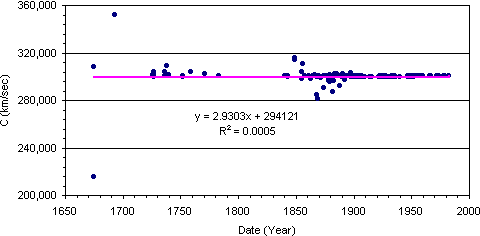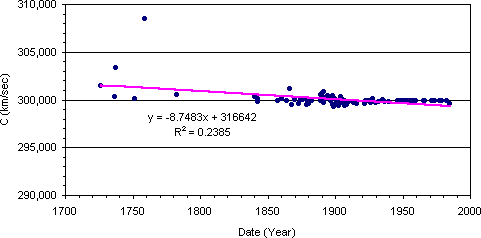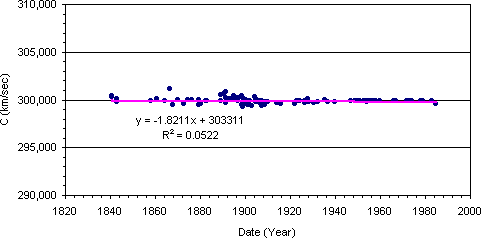Is the Speed of Light Decreasing?

Introduction
A common young earth argument for a young earth is that the velocity of light has been decreasing exponentially since the creation of the universe.1 One of the most significant implications of a rapidly decaying speed of light is that the universe could actually appear to be much older than it really is. This is because, in the past, the speed of light would have been much faster, meaning that light would have traveled much farther, making the universe appear old even though it were young. This page will examine the problems associated with the theory, both in terms of how the universe works, and the data used to support this claim.
Theoretical problems
Theoretical problems abound with the idea that the velocity of light might be changing with time. Einstein's famous theory of general relativity is the most serious challenge. To remind you, the theory is reproduced below:
E = mc2
where E = energy, m = mass, and c = velocity of light
Although still called a "theory," Einstein's equation has survived the tests of nearly a century of observational confirmation.2 The equation above shows that any change in the velocity of light results in huge changes in either the amount of energy or mass in the universe. For example, a modest 2-fold decrease in the velocity of light would result in a 4-fold decrease in the amount of matter, or amount of energy in the universe. There is no evidence that any of these kind of changes are occurring in our universe.
Observational problems
 Figure 1. Velocity of light for 193 values for the years beginning in 1675.3 |
Not only are there theoretical problems with the decay of the speed of light, but the data used to support this concept is less than convincing.3 Figure 1 (above) shows the data from 193 studies beginning in 1675. The only thing notable about the data is how constant the speed of light has been using these 193 uncorrected values. It can be seen that the deviation from the linear regression is largest in the past (which would be expected, given the primitive nature of the early experiments). Very little deviation from the regression line can be seen for values reported during the last 100 years. The "R2" value reported on Figure 1 is a measure of the kind of linear relationship represented by the data. An R2 value of 1.0 indicates a perfect linear relationship between the two variables (in this case, between the date and the value of C). A value of 0.0 indicates that there is no relationship between the two variables. In Figure 1, the R2 value of 0.0005 indicates that there is no significant relationship between the velocity of light and time.
Deceptive, selective reporting of data
 Figure 2. Velocity of light for 120 selected values for the years from 1727 to 1983.3 |
Not being content with these numbers, young earth creationists selected and corrected the values to produce the figure seen to the above (Figure 2). Some of the best values were eliminated because they did "not come under the proposed hypothesis." These numbers included the values that were determined using laser measurements and the atomic clock - the most accurate measurements.
The real nature of the speed of light
 Figure 3. Velocity of light for 114 of 120 selected values for the years from 1800 to 1983.4 |
Looking at the above figure, one notes that the slope of the line is largely determined by a few points done in the 1700's, at a time when methods were crude and very susceptible to large errors. A plot eliminating the first 6 values from figure 2 (all those before 1800), produces the plot seen in Figure 3 (right). As can be seen, the values recorded from 1840 to 1983 have not significantly changed over that period of time.
Conclusion 
A constant speed of light is a problem to young-earth creationism, since the nature of the creation (i.e., the large distances between galaxies) requires either an old universe (required for light from the oldest galaxies to travel to earth) or one that was made to deceive people into thinking it was old. An exponentially decreasing speed of light solves both problems, since the large distances between galaxies could be explained by a much faster speed of light in the past, and God would not have had to create the universe with "appearance of age." However, the young earth hypothesis that the velocity of light has been decreasing with time is contradicted by both theoretical and observational conflicts.
Speed of light update
Beginning in 1999 with preliminary observations on 30 quasar spectra,5 the absorption lines caused by magnesium and iron atoms seemed to have shifted slightly relative to accepted laboratory measurements. Since quasars are very old structures (all were formed near the beginning of the universe), these results imply that the fine-structure constant of the universe has changed since the beginning of the universe.
More recent data, published in 2001,6 but popularized in the press in August, 2002, confirmed the preliminary data, and established the amount by which the fine-structure constant has changed. It turns out to be 0.001 per cent smaller (1 part in 100,000). Unfortunately, the popular press has jumped on the study and published outlandish, sensationalized accounts of the study, claiming that the results suggest that time travel might be possible (Not!). Some people who are involved in young earth creationism have bought the idea that the speed of light might have been faster in the past without knowing the incredibly small amount by which the constants have actually changed. The studies do not support the idea that the speed of light was exponentially faster in the past.
However, the results tend to confirm string theory, which states that the universe was formed from ten dimensions, six of which have remained in their original tightly curled configuration. The slow uncurling of spacetime would be expected to produce changes in the fine-structure constant of the universe similar to what was observed. Confirmation of extra dimensions of space and time are important concepts in Christianity, since the Bible claims that God exists outside the physical universe and its dimension of time, although He can also interact within the universe as He chooses. For more information, see The Extradimensional Nature of God.
Related Pages 
- Ball, P. 2001. Fundamental constant swells. Nature (Science Update).
- Chris Churchill's Fine Structure Constant Page (from one of the authors of the study)
- Microsoft Excel Spreadsheet for speed of light data online.
References 
- Not all young earth creationists believe that the speed
of light is decreasing. See:
Evered, M. G. 1993. The recent decrease in the velocity of light--what decrease? Creation ex nihilo Technical Journal 7:93-102.
Evered, M. G. 1995. The velocity of light: constant yesterday, today and tomorrow. Creation ex nihilo Technical Journal 9:102-105. - Observational Verifications of General Relativity from Reasons To Believe.
- Montgomery, A. and L. Dolphin. 1993. Is the Velocity of Light Constant in Time? Galilean Electrodynamics: 4, Sept/Oct 1993.
- Microsoft Excel Spreadsheet available online. Don't have Microsoft Excel? Download the Excel 8 Viewer first from the Resources Page.
- Webb, J. K., Flambaum, V. V., Churchill, C. W., Drinkwater, M. J.. & Barrow, J. D. 1999. Search for time variation of the fine structure constant. Physical Review Letters 82: 884-887.
- Webb, J. K., et al. 2001. Further evidence for cosmological evolution of the fine structure constant. Physical Review Letters 87: 091301.
http://www.godandscience.org/youngearth/speedlight.html
Last updated January 16, 2006


